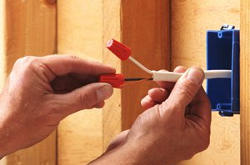Switches, Outlets, and Fixtures
See if We Have Top-Rated
Electrical Contractors in Your Area

Switches, outlets and fixtures are the gateways through which your electrical juice pours. Of course, you probably already have a pretty firm grip on what electrical switches and outlets do, but you may not realize what they can do for your home. Redesigning the layout and function of your switches and outlets can be the gateway for more than your electrical needs; it can be the catalyst that allows you to completely redecorate your home. Here's the lowdown on what electrical outlets and switches do and some ideas for upgrades, repairs, or replacements.
Electrical Switches
The most familiar electrical switch is the common light switch, referred to by hardware dealers and electricians as a single-pole switch. A switch that operates lights from two locations—the ends of a hallway, for example—is called a three-way switch. Some electrical switches are operated with keys, timers, or photoelectric eyes that sense daylight. Some switches are paired up with outlets (a combination switch) and others have their own indicator light to let you know the switch is on. Outdoor electrical switches are mounted in a special box and operated with a lever. Special dimmers are needed for fluorescent and neon lights and loads greater than 1,000 watts. Switches should match the amp and voltage ratings for the circuit. If your home has aluminum wiring, the switches should be designated CU-AL for compatibility.
Electrical Outlets
Electrical outlets, sometimes called receptacles, provide a place to plug in lamps, toasters, and other electrical appliances that are not "hard-wired" or permanently wired to the electrical system. In the United States, most standard home electrical circuits are on a 120-volt line. Conventional outlets have two places to plug in devices and so are called duplex outlets. Contemporary outlets include a half-round hole that receives the grounding plug on an electrical cord. A wire leads from this hole to the system's ground to provide protection against shock when an appliance is plugged into it.
In older homes, electrical outlets aren't always fitted with grounding plugs; they have only the paired slots. If your home's outlets are like these, you've probably discovered grounding adapters, those little plugs that convert the end of a three-pronged plug to two-pronged. If you use one of these, be sure to attach the adapter's grounding metal flange to the wall receptacle's center screw, which must be grounded. Otherwise, you'll defeat your electrical system's safety grounding. Revamping these old two-pronged electrical outlets is a common electrical upgrade for homeowners.
Make a smart yet subtle home improvement! Use this link to
Install New Fixtures
Electrical Fixtures
Although some older homes still have single light fixtures plunked squarely in the center of each room's ceiling, many of today's houses employ a much more sophisticated lighting scheme. A variety of fixtures, thoughtfully placed, add to the function, comfort, beauty, and drama of a house. Experts group lighting types into three categories: general, task, and accent.
General, or ambient, lighting provides overall illumination by way of ceiling or wall-mounted fixtures, chandeliers, recessed lights, or track lights.
Task lighting is more specific, supplying direct light for reading, sewing, and cooking.
Accent lighting can add drama by spotlighting objects or highlighting interesting aspects of a house. Still, each type of lighting starts with your ability to turn it off and on. If it's time to redecorate your home, this is a great place to start.
More Tips & Advice For Your Home
- Related Articles
- Recent Articles

